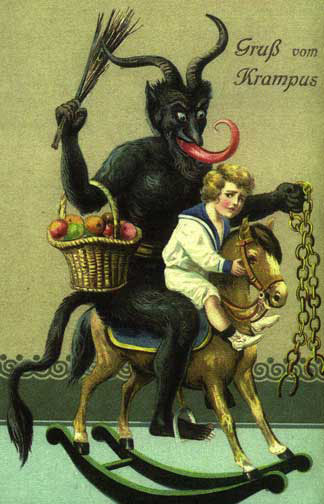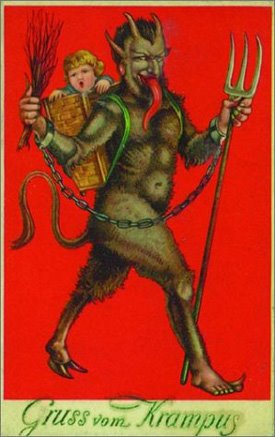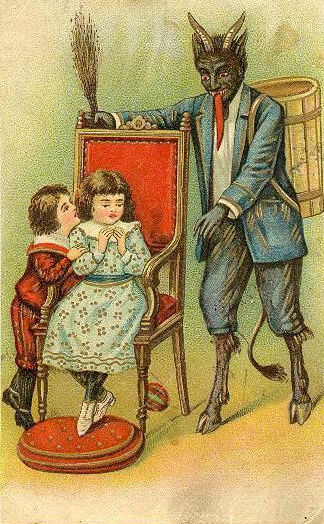TONIGHT’S LECTURE HAS BEEN CANCELLED AND WILL BE RE-SCHEDULED FOR EARLY JANUARY. Reports of the Mother of All Blizzards, which is predicted to dump up to 20 inches of snow across the Northeast, have dissuaded me from braving gale-force winds and man-eating snowdrifts. Somehow, the thought of fishtailing all over the Garden State Parkway or, alternately, marooned in Grand Central doesn’t appeal. Nor would I wish that on any attendee devout enough to risk such hazards. Let’s try again in early January, shall we?
But if you are in the area and easily able to attend the Observatory’s Krampus party, please do! Host Joanna Ebenstein writes to say that the “Observatory Krampus-Themed Holiday Party, inspired by our favorite Christmas character, Krampus, St. Nicholas’ mischievous/evil Eastern-European sidekick,” still very much ON. “We had planned to begin the party at the end of Dery’s lecture, but will now begin at 8:00 PM, to amuse the disgruntled masses who did not recieve this cancellation alert. The party is free of charge, and will feature live-music (Krampus-Carols!) by Ruprecht and the Birch Switches, holiday gifts, birch-switch-beatings, treats, rusty chains, lolling tongues, and, of course, booze. Entrance to the party is free, but do bring cash for buying drinks, treats, & holiday gifts!”

“How the Lord of Misrule became a Bourgeois Tool (And Still Managed to Enrage the Religious Right)”
DETAILS:
LOCATION: OBSERVATORY, BROOKLYN. DIRECTIONS HERE.
Date: Saturday, December 19th
Time: 8:00
Admission: $7
WHAT: An illustrated lecture, followed by a Festivus—er, Observatory Holiday party, “complete with lovely alcoholic beverages, themed snacks, and live music as performed by Brooklyn’s own Ruprecht and The Birch Switches, who will perform your favorite Krumpus Carols.”

Few Americans know that Santa descends from the mock king who held court at Saturnalia, the Roman festival celebrating the winter solstice. Or that he shares cultural DNA with the Lord of Misrule who presided over the yuletide Feast of Fools in the Middle Ages—lewd, blasphemous revels that gave vent to underclass hostility toward feudal lords and the all-powerful church.
By the late 19th century, Christmas in Manhattan was an excuse for the rabble to go wilding from door to door in upper-class neighborhoods, demanding booze and cash from terrified householders in exchange for an off-key (and sometimes off-color) yuletide song. In desperation, Washington Irving, Clement Clarke Moore, and other members of New York’s cultural elite invented Santa Claus—and Christmas as we know it—as a means of domesticating the drunken revels of the dangerous classes. Their bourgeois myth was designed to channel lumpen unrest into a more acceptable outlet: a domestic ritual consecrated to home, hearth, and conspicuous consumption.
In “Satan and Santa: Separated at Birth?,” Dery, a cultural critic and book author, takes a look at the Jolly Old Elf’s little-known role as poster boy for officially sanctioned eruptions of social chaos, as well as his current status as a flashpoint in “the Christmas Wars”—cultural battles between evangelicals, atheists, conservatives, and anti-consumerists over the “true” meaning of Christmas. Along the way, Dery considers New Age theories that Santa is a repressed memory of an ancient Celtic cult revolving around red-capped psychedelic mushrooms; Nazi attempts to re-imagine Christmas—a holiday consecrated to a Jewish baby, for Christ’s sake—as a pre-Christian invention of tree-worshipping German tribes, in some misty, Wagnerian past; and the suspicious similarities between Satan and Santa, connections that have fueled a cottage industry of conspiracy theories on the religious right.

He sees you when you’re sleeping/ He knows when you’re awake/ He knows when you’ve been bad or good/ So be good..for goodness’ sake!

Harry Fix
Wish I could attend your talk. Theme- oriented snacks sours curious. Ever thought of video taping it? It would be great to have a document of your fine work.
M. Dery
Great idea, H.F. I’ll look into it. If it proves do-able, maybe I’ll post the results, or at least a link to the results, here.
Boing Boing
New York: Mark Dery lecture on Satan and Santa
What do Satan and Santa have in common? Former BB guestblogger Mark Dery will speak on the topic Saturday evening at the Observatory alternative art/lecture space in Brooklyn, New York: In “Satan and Santa: Separated at Birth?,” Dery, a cultural criti…
Kate
The Satan with child drawings are really something! Interesting to see the lyrics for “Santa Claus is Coming to Town” underneath the last image. The song makes my young son cry every time. The idea that someone can see him and knows if he has been bad or good is very frightening to him! I guess he must have a guilty conscience! I feel bad for encouraging belief in this Santa deity. It seemed so innocuous, but for a young impressionable mind, it really isn’t.
B.H.
not Satan, the Krumpus!
Bob
Sounds like a great time, and would go right along with the Santa scholarship fostered by books like Santa Claus, Last of the Wild Men, by Phyllis Siefker and When Santa Was A Shaman, by Tony van Renterghem. It sounds like you’ve incorporated their thoughts and gone deep into others.
So put another tic on the tally of folks that would enjoy being able to see some post-event video.
M. Dery
Bob: You’ve outed my crib notes! Yes, I’ll be leaning heavily on the sources you mention, and others; still excavating this dauntingly deep cultural landfill—Santa’s geneaology (sp.?) seems to go on and on forever, all the way back to the Greeks at least, and likely back to our knuckle-walking, Quest for Fire days. I’m relying on what I’m sure will be a whip-smart audience to de-bug this early drag and sharpen my analysis, during the Q&A. I’m test-driving (yet another!) book idea, here.
Will try to post text or video here, after the fact.
Kate: Well, if panoptical surveillance spooks the kid, caution him to give Xtianity a wide berth. Hitchens likens the all-seeing eye of Mordor—er, Yahweh—to Kim Jong Il’s North Korea, and by my lights he’s not wide of the mark. I’m Switzerland on the question of the psychic trauma inflicted by teaching kids to believe in Saint Nick. There are those who think it encourages credulity; others argue that the inevitable realization that Santa Claus is a fiction offers an early, instructive taste of Losing Your Religion, and fosters skeptical inquiry about all such cultural concoctions, going forward. Of course, belief in Santa could have both effects, for maximal cognitive dissonance. You wouldn’t believe how many psychology journal articles have shed ink on this question, if not light.
Bob
Mark & Kate: Don’t forget the social and cultural use for a belief in Santa Claus, too. There is a great deal of what it is to be a child in the US wrapped into either being one of those kids who grew up with the twin traumas of believing in then unbelieving in Santa or in being one of the cultures who view Santa from the outside.
A large part of what kids learn about sharing, gifting, and acceptable secrets comes from lore around Santa Claus. There is also the shared bond of family that comes with rituals around Christmas celebrations regardless of the level of belief and adherence to Xian dogma, and often “Santa stuff” is a large part of that intra-family bonding. Then there is the whole mythic canon of films, books and television that provide, with Mickey Mouse being almost the only other example, a mostly secular guide to what it is to be selfless, how to love without guile, and how to deal with conflict without violence.
Then there’s the reverse side involving the socially common experience of un-believing in Santa, where kids get a first experience in learning how mysteries are communicated (as often peers are the ones who break the “there’s no Santa” news), the “OMG, adults lie!” moment, the learning of the stages of grief, and later, how ritual (the re-creating of Santa for their children) allow them to re-connect with the departed. And while these are all fairly traumatic, it’s my understanding of psychology that they are part of the experience of growing up and becoming adult and as such, are pretty tame alternatives.
Having all these elements wrapped within what is probably the strongest mytho-poetic framework left in US culture is pretty important to me, and that’s kinda why I study the fat man.
RJ
Interesting. Incidentally, I read somewhere that the Amanita muscaria mushroom is tied into the whole Santa Claus myth.
Funny that you mention the panopticon– I wrote a paper in college comparing Bentham’s idea with Santa. I know it certainly worked on me. “You mean he can see everything I do? Everything?!”
Anyway, good stuff!